From
the field
Notes from our
fields and seed production at Coyle Organic farm.
|
Feb 27 2025. This is what our rye field looks like. Just
waiting for the greenery to come through so I can put the horses
out to pasture on part of it.
|
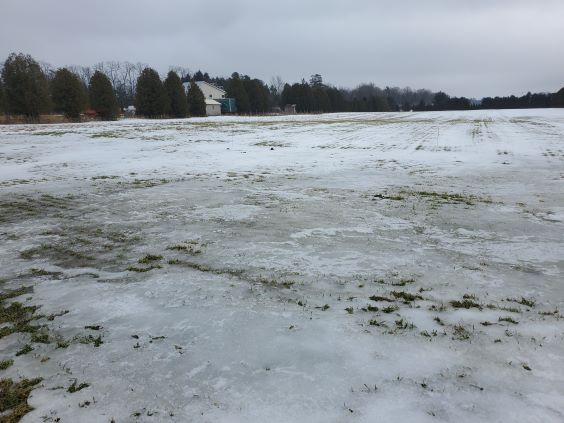
|
|
Sept 2 2024. Plowing the field for planting the rye/sunflowers
|
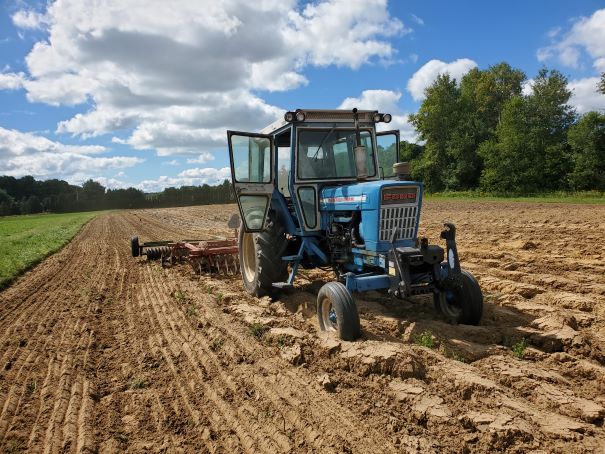
|
|
June 17 2024. Today we dehulled more spelt. We actually emptied
the bin so the next spelt will be from the field.
|

|
|
March 12 2024. This is the setup to clean the corn that Oscar
brought us a few days ago.
|
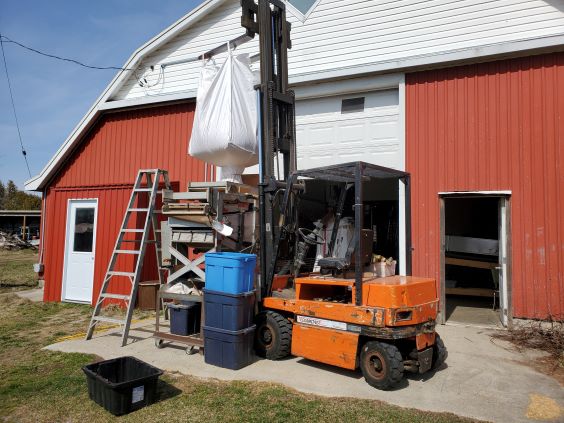
|
|
March 12 2023 Here is Jim. Chief and Ginger pulling the tine
weeder. This was perhaps the first time Chief was in a team. He
outdid both Ginger and Jim but he still had a bad angle on this
left hind quarters which did not seem to bother him. Will keep an
eye on it,
|
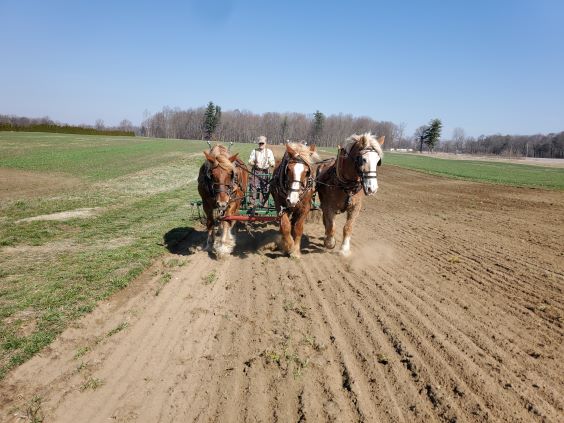
|
|
March 1 2024 planting oats. The field was frozen this morning
but with the sun it dried up fairly well. There were some wet
areas but most was pretty good. I'll have to wait and see what
grows and hopefully there is no more deep freezes to kill the
germinating oats.
|
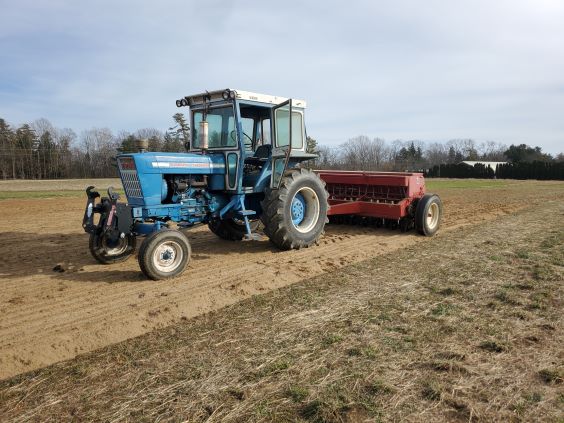
|
|
The Oats planting drill march 1 2024
|
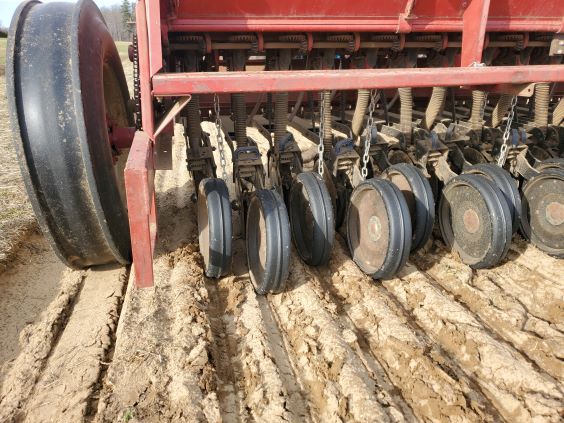
|
|
Nov 20 2023 This is a good view of the residue left after a
crop was finished and the crimped rye has been broken up by the
horses. There is also some clover coming through which will be
ready for spring!
|
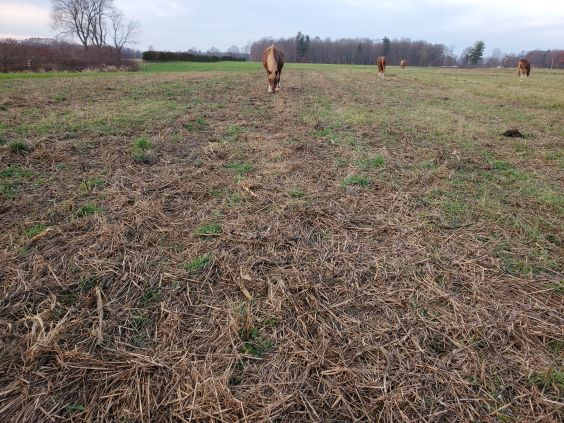
|
|
Nov 16 2023. The field of sunflowers just about ready to
combine.
|
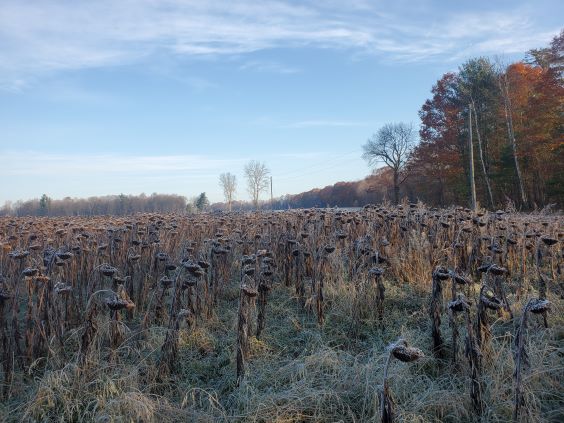
|
|
Aug 3 2023.
The rye was harvested but it was the worst yield I have seen in
years. I notice too that other fields of rye close by where also
very poor. The year has been wet and hot and there are lots of
weeds everywhere. Certainly a very unusual year.
|
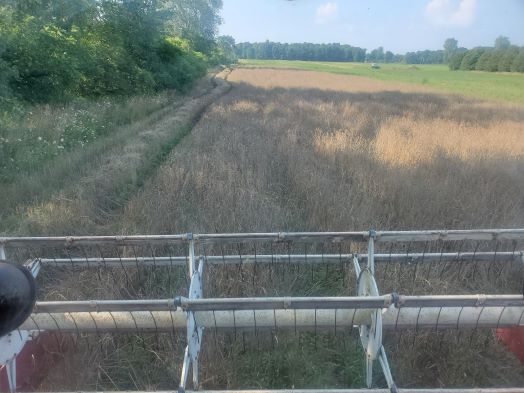
|
|
August 4 2023.
This has been a very unusual season. We had about 3 weeks with
no rain then we got too much rain ever since. The sunflowers have
seemed to do very well but still not with the heads yet.
I combined the rye and spelt and both did very poorly this year
and that seems to be also true with other farms close by for those
crops.
There has been a tremendous number of weeds coming up all over,
and many weeds that I had though where no longer in the fields.
In the area I planted oats and clovers the weeds came up and I
had to re-plow and replant the field they where so bad. In one
area I plowed many times to discourage the weeds but they still
persisted.
|
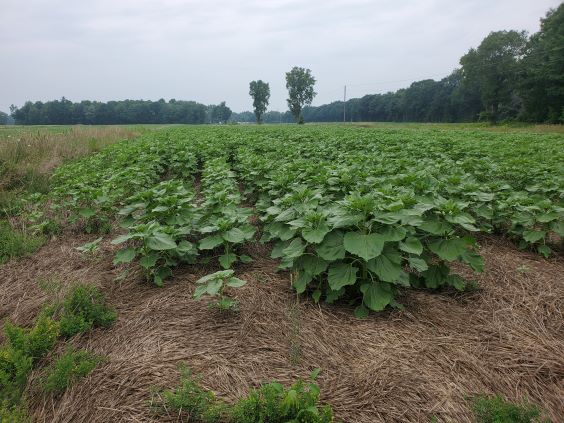
|
|
July 25 2023. I had some sunflowers that did not get cleaned
from last season sunflowers so today I cleaned them. Worked very
well.
|
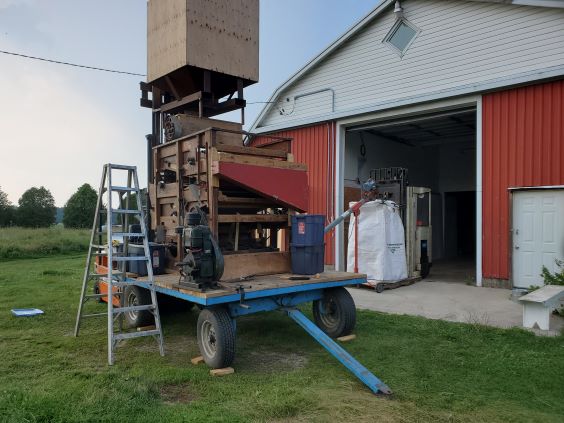
|
|
July 24 2023. I over planted the horse pasture which was
sunflowers last season with a hay mixture with 25 % alfalfa . The
coulter cart makes an opening so the seed drill can plant in some
seeds. Lets hope this works... but no hurry as I hope it will
germinate in the late fall and spring.
|
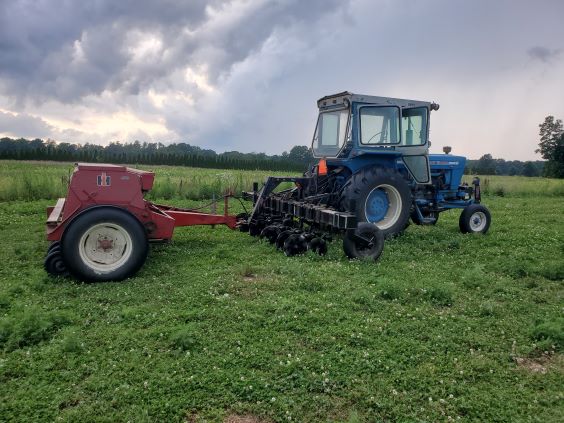
|
|
April 15 2023. Jim and chief are plowing a field ready to plant
oats which will be terminated in the fall to plant rye for
crimping and planting sunflowers.
|
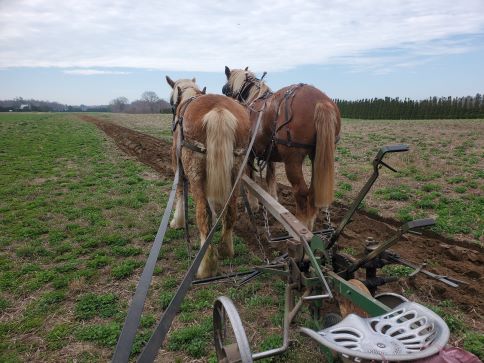
|
|
June 9 2022 Planted the corn and here I am tine weeding the
field just after palnting to keep the weeds down.
|
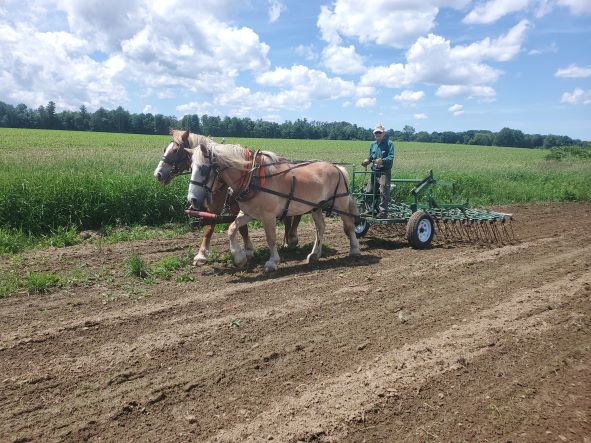
|
|
June 10 2022, The red clover did very well so I let the horses
eat it. My idea is to have the horses eat the red clover and later
in the fall combine it for seed.
|
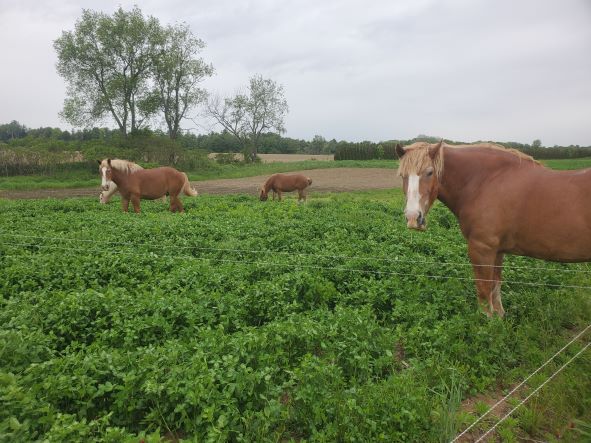
|
|
May 17 2022 The horses and Mat have been busy plowing up the
winter kill oats and radishes. I put the oats in just too late
last year so not enough residue so I plowed it. Marvellous how
well the horses performed over a few days.
We have been working in the early morning as the days have been
too hot.
|
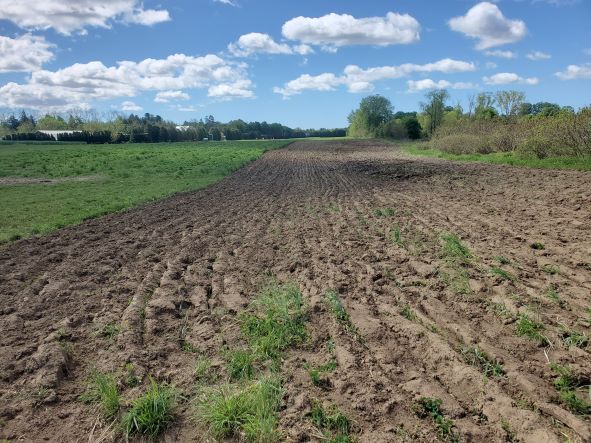
|
|
May 17 2022 Got a load of mushroom compost which I have been
spreading on the pastures
|
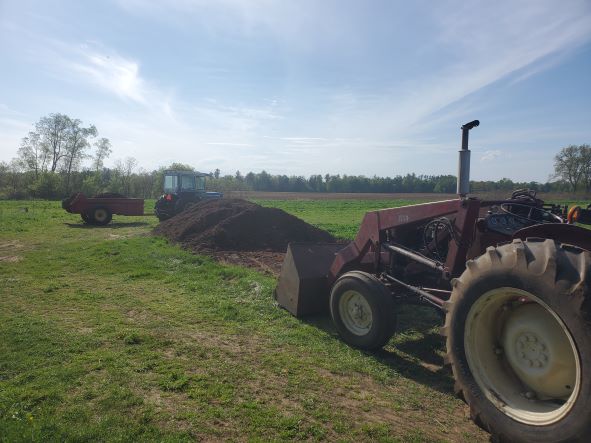
|
|
April 29 2022. Moved the row of compost over with the use of
the manure spreader and the Front end loader.
|
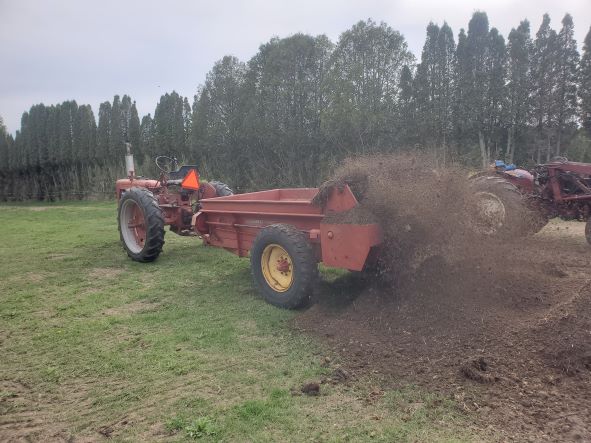
|
|
April 29 2022 The camelina planted back in February is doing
well.
|
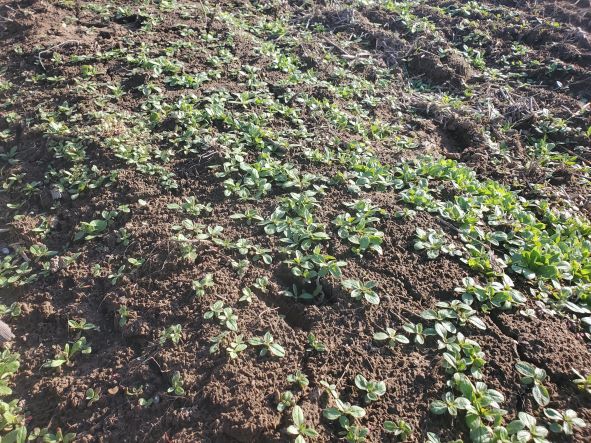
|
|
April 29 2022. The red clover hs done very well in my last
seasons cultivated sunflowers.
|
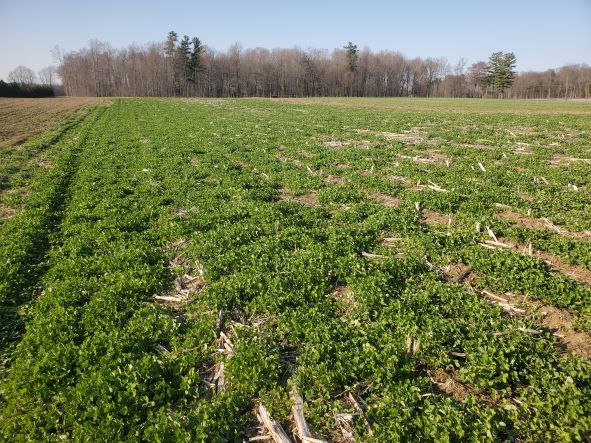
|
|
April 17 2022 . One can see the 1.5 hp diesel motor that runs
the clipper seed cleaner. Quite a set up and it took me about 2
years to get this clipper cleaner restored. There are still a few
things I would like to change which will get done.
|
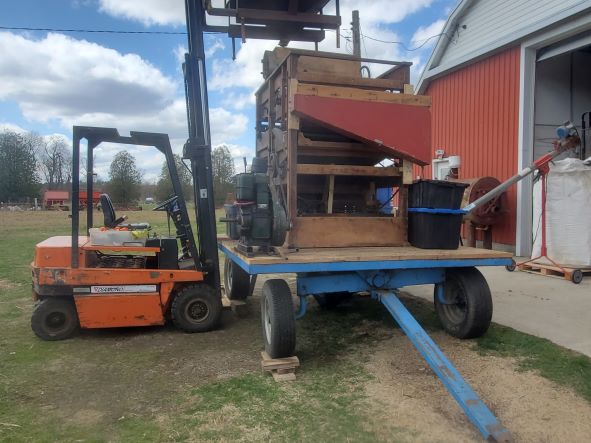
|
|
April 17 2022. Finally got the Clipper seed cleaner working
well. Here I am cleaning sunflower seeds that I harvested last
fall. The Cleaner is run by a small diesel engine which took some
time to get all the correct sizes of pulleys to make it run well.
|
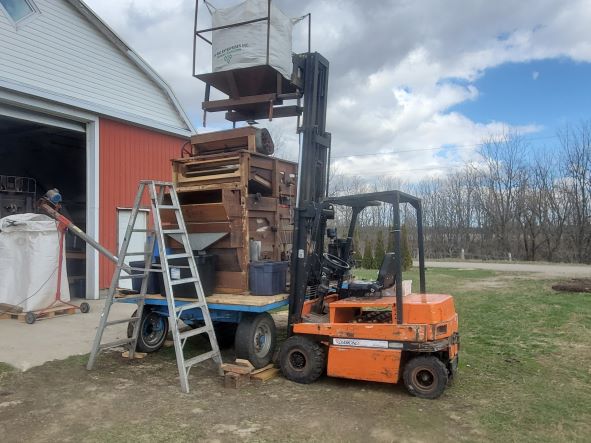
|
|
April 16 2022. I was just digging up a few weeds in the rye
patch when I discovered many worms! When I first started farming
here there were no worms.
|
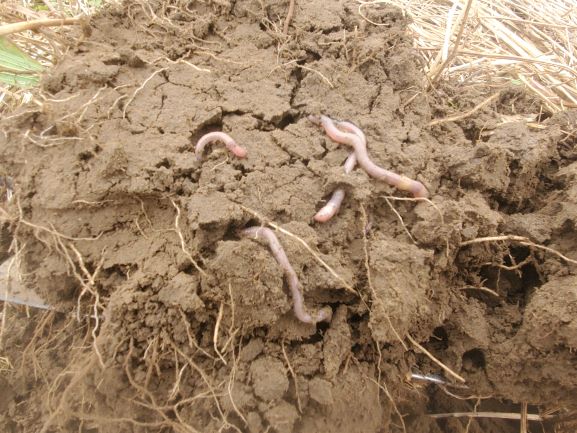
|
|
April 16 2022 . This is the sunflowers and corn planted without
anything else.
|
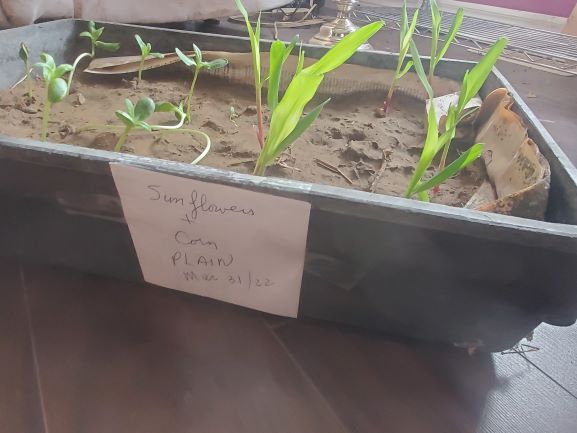
|
|
This is the recently planted corn and sunflowers using the
agsol 13 amino acid fluid. The added amino acids do seem to be
better.
|
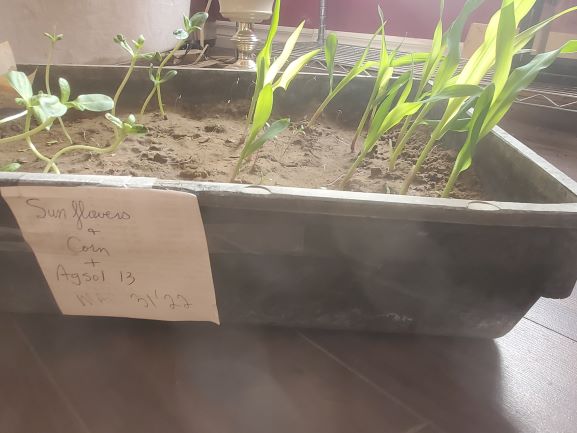
|
|
April 15 2022. Looking down the last season cultivated
sunflower field showing the red clover coming on strong shown
below closeup.
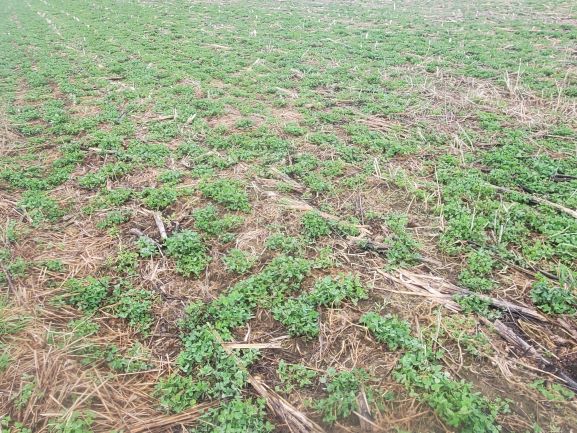
|
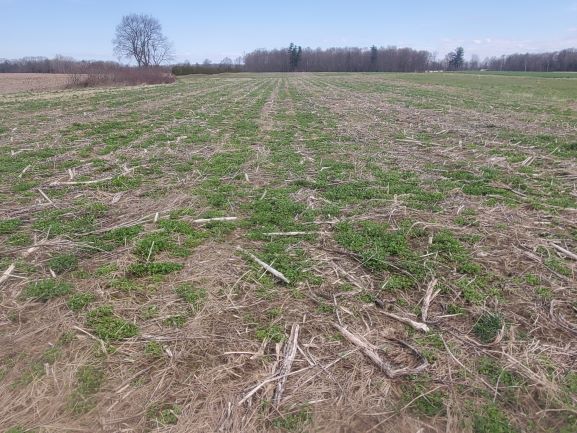
|
|
April 15 2022. The spelt field beside the horse pasture. The
spelt is coming along well. And this is the first day the horses
are on the old crimped rye and sunflowers field. I had let them
out just for a couple of hours each day before this.
|
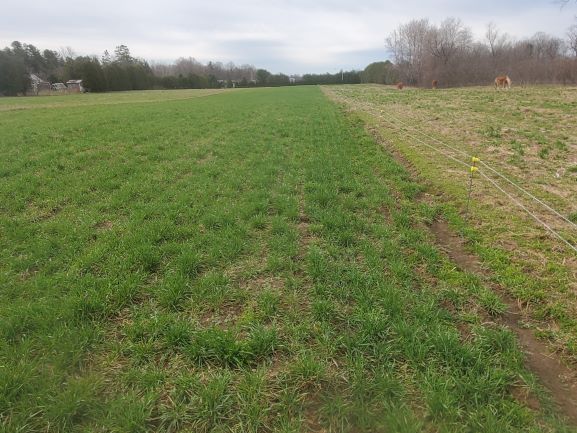
|
|
April 15 2022. Spreading mushroom compost on the garden beds
using a manure spreader which worked very well.
|
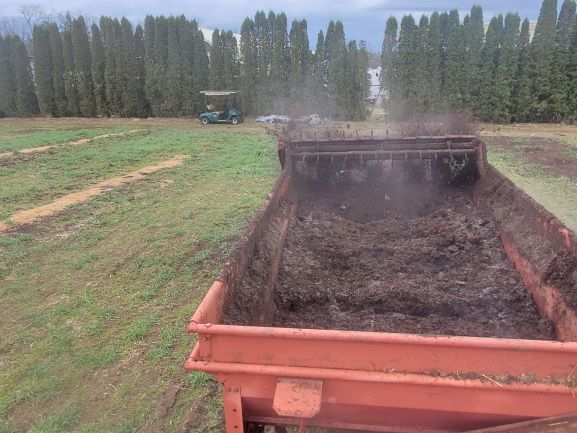
|
|
April 15 2022. Yes! That is rehizosheaths formed on the rye
roots. This shows that there is indeed some microbes doing their
work. I was just weeding some of the beds when I noticed the
wonderful coating of the roots by the microbes.
|
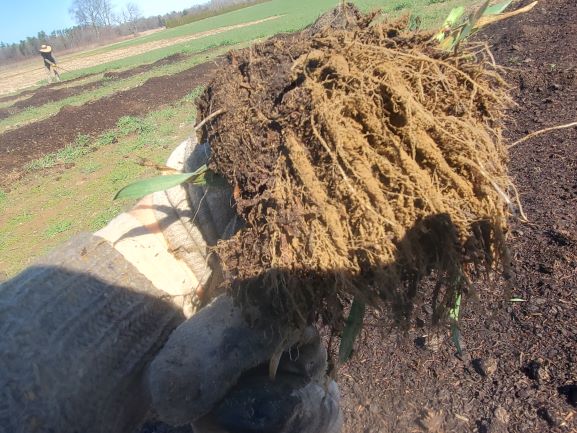
|
|
April 8 2022 Yesterday I broadcast seeds over the disc'd corn
stalks. Today I packed the seeds. Ginger and Chief doing the work.
|
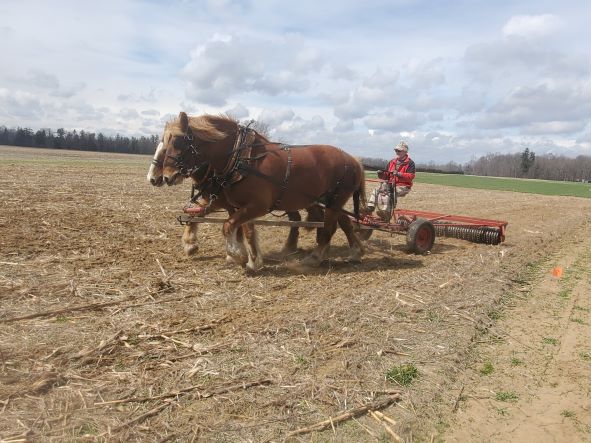
|
|
April 8 2022 and the camelina is doing very well.
|
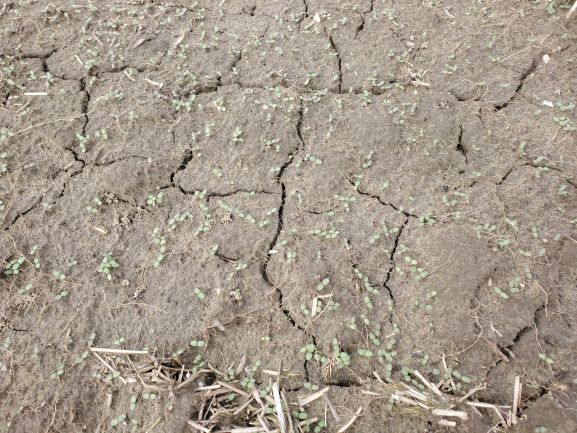
|
|
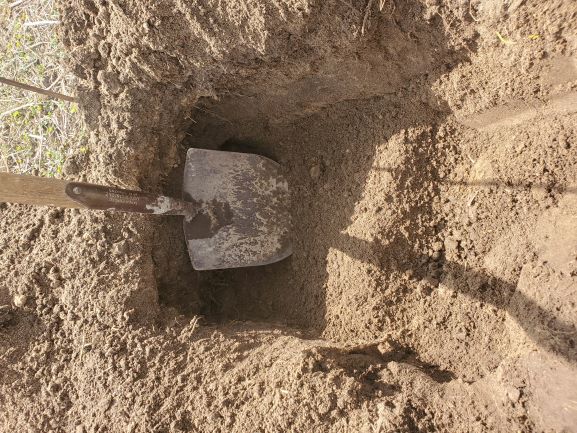
April
7 2022. Dorothee dug up the potatoes that she buried in the
garden. This is a very good way to have fresh potatoes in the
spring. She had to bury them quite deeply to not have them frozen.
|
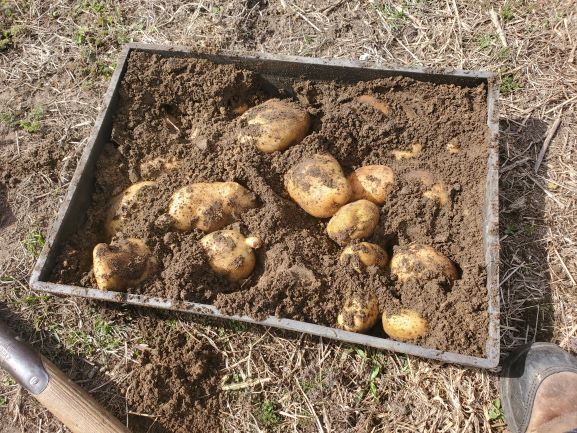
|
|
April 5 2022. Thought it was dry enough to disc the bush hogged
corn stalks. Doing just a surface disc and will then spread some
clover and grasses. In a couple of months I will plant oats once I
have sickle mowed the weeds.
|
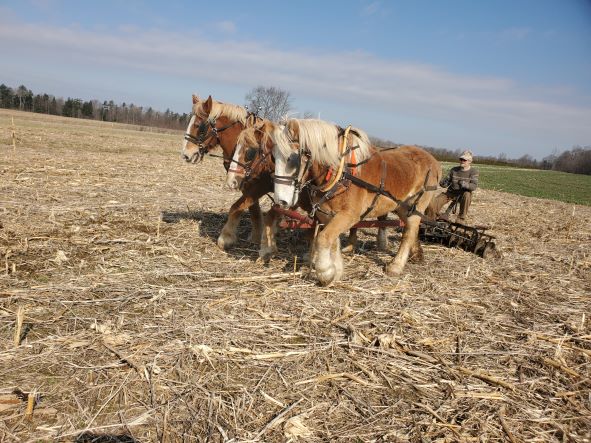
|
|
April 3 2022. I have long wanted to do more composting but
never figured out a way to do it until lately. Just fill the
manure spreader with material and then let it mix the contents to
make windrows.
|
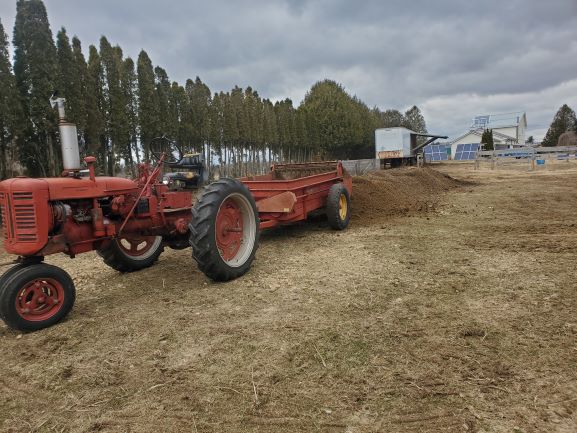
|
|
Marc 29 2022. While I was looking at the camelina I took a
photos of the clover coming up in the last years sunflower field.
In the last cultivation I spread some red clover. Since last years
crop of sunflowers was done without the crimped rye the weeds were
severe.
This season I am not going to plow as that does bring up more
weeds and adversely affects the microbes. I will wait until the
weeds start to grow then clip them with the horses pulling the
sickle mower. In late May I hope to plant oats and get a crop too!
|
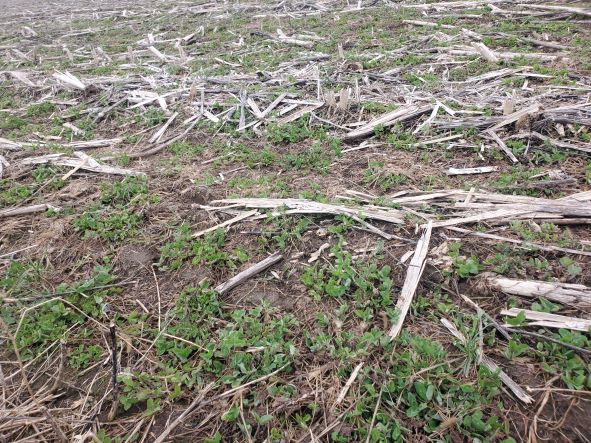
|
|
March 29 2022 after two very co0ld days at about minus 7
degrees Celsius. Still looking very good!
|
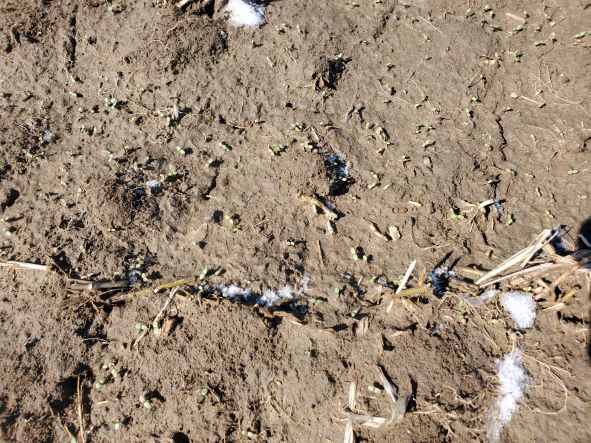
|
|
March 25 2022 The camelina is doing just fine.. lets hope there
is no minus 15 degree Celsius in the next few weeks.
|
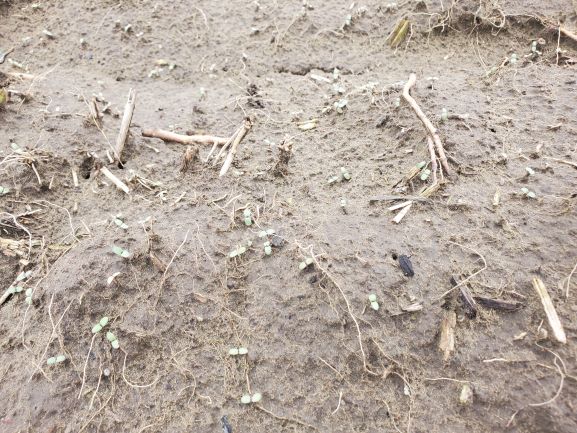
|
|
March 25 2022 more camelina showing.
|
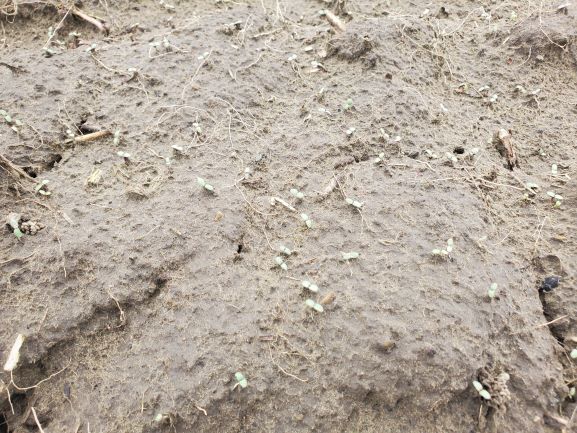
|
|
Clover in the previous cultivated sunflower field. I've decided
to not do any plowing but will sprinkle more seeds over then when
the weeds get going I will clip in about a month say second week
in may then plant oats as an experiment. I will be able to
separate the oats seeds from any weed seeds..
Mar 25 2022
|

|
|
Yes!! The camelina is germinating. It is very small but
certainly visible March 20 2022
|
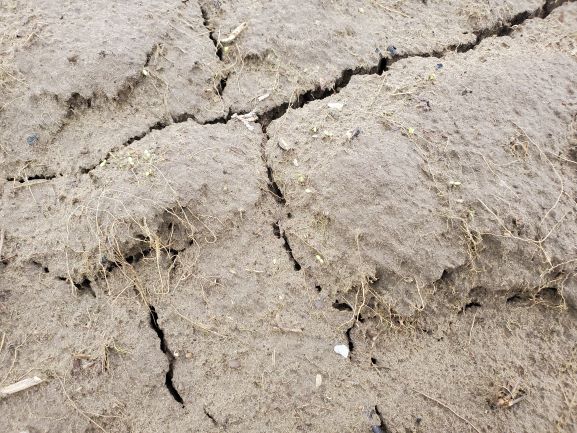
|
|
Last years crimped rye that grew sunflowers. The red clover is
showing through and what a wonderful lot of carbon that will take
time to incorporate in the soil by the microbes .March 2022 .
|
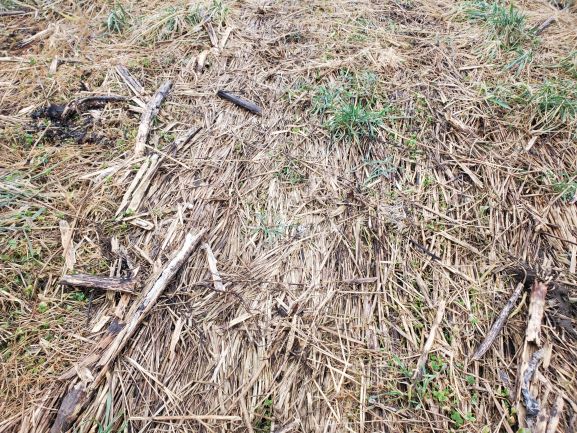
|
|
Marc 20 2022 . The spelt is coming along just fine.
|
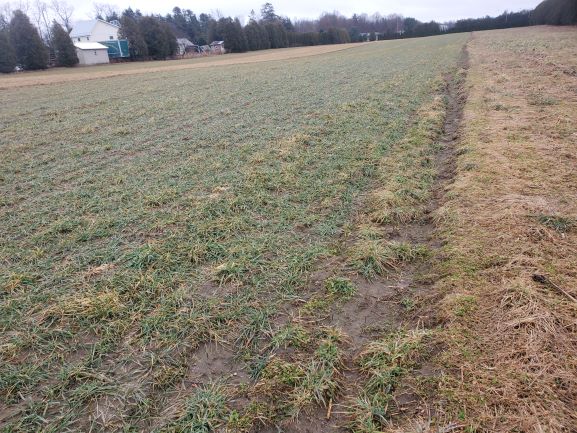
|
|
March 20 2022. The rye is doing just fine too. We will be
crimping the rye in late may and Planting sunflowers and a trial
of corn.
|
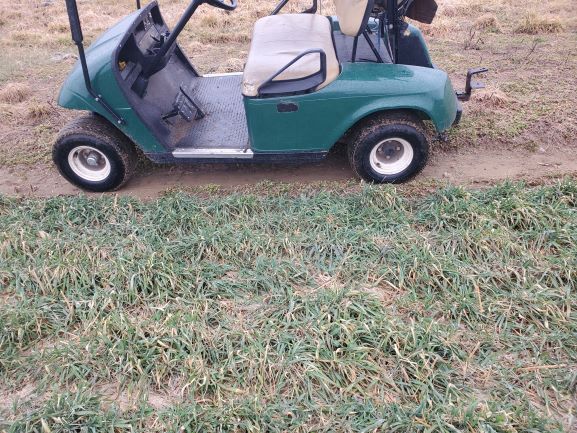
|
|
March 5 2022. As I was bush hogging the corn stalks Dorothee
was picking the last of the corn for the animals and our corn
meal.
|

|
|
March 5 2022. The weather was warm but the ground still frozen
so the tractor was able to bush hog the corn stocks giving a nice
mulch for the microbes,
|
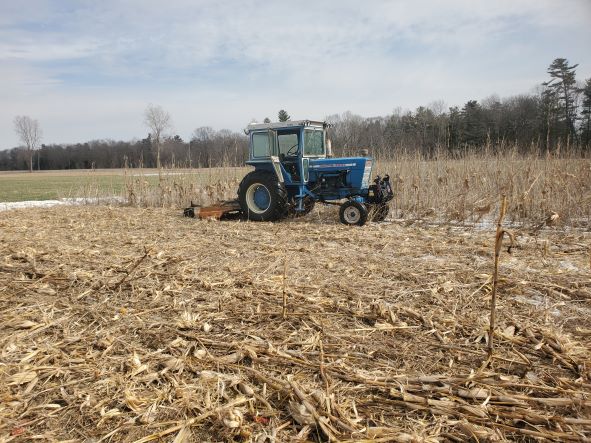
|
|
March 3 2022, got the sunflowers put in the bin. Was very lucky
that the ground was still frozen and warm enough to work.
|
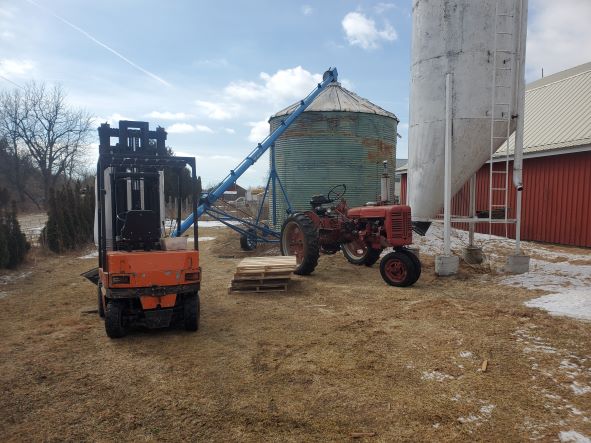
|
|
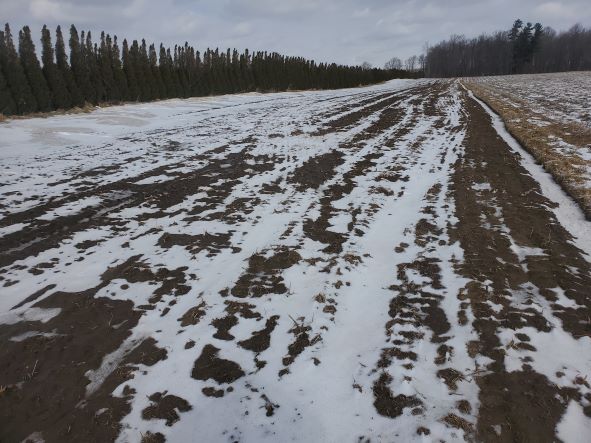
|
Feb 26 2022. I decided to spread my camelina on this field that
I prepared with the horses last fall.
|
|
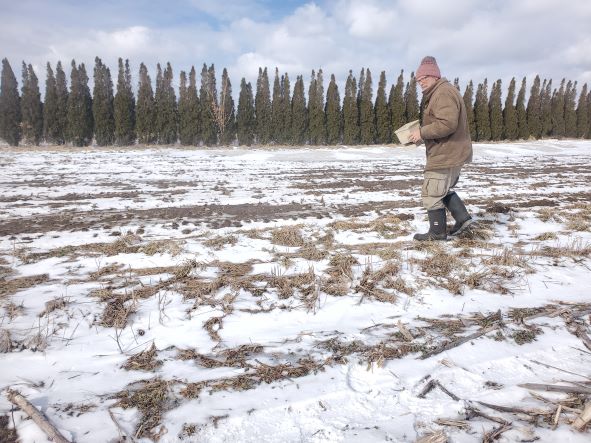
|
Feb 26 2022. Just starting out across the field with the hand
spreader.
|
|
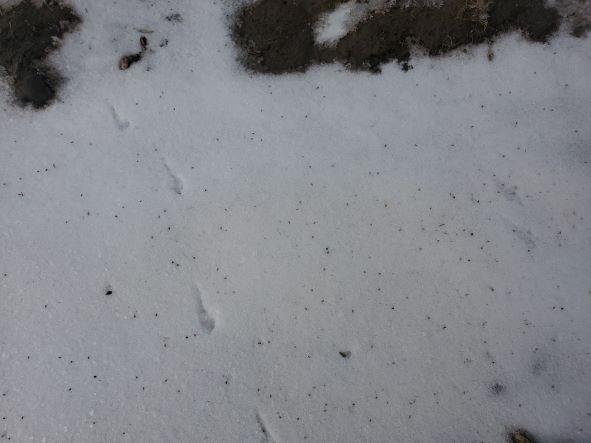
|
Feb 26 2022. If one looks closely you can see little specks of
camelina seed on the snow.
|
|
The corn field on Jan 15 2022. We could not combine the corn as
there was some mould on the cobs so we decided to hand pick which
is on going. I will bush hog the stalks and let the red clover
take over and be a pasture without tilling..
|
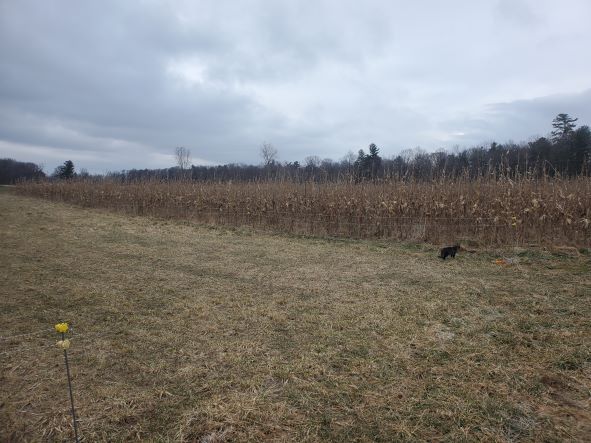
|
|
The newly planted multi species pasture getting going for the
spring. To help with the weeds I will sickle mow it with the
horses in the spring. Jan 15 2022
|
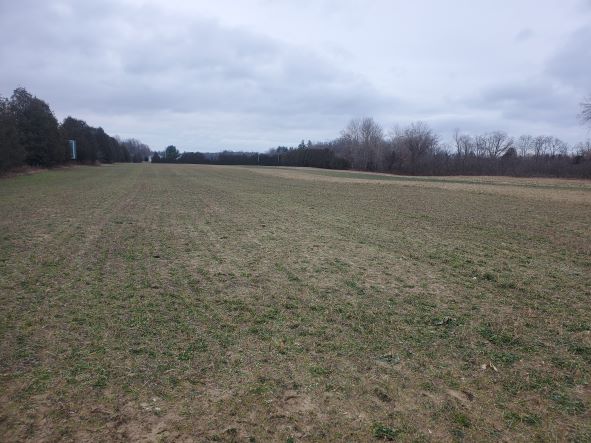
|
|
On the left is the winter kill field of oats and Radish. The
recent very cold weather has killed it and I will plant directly
into the residue in the spring. Jan 15 2022
|
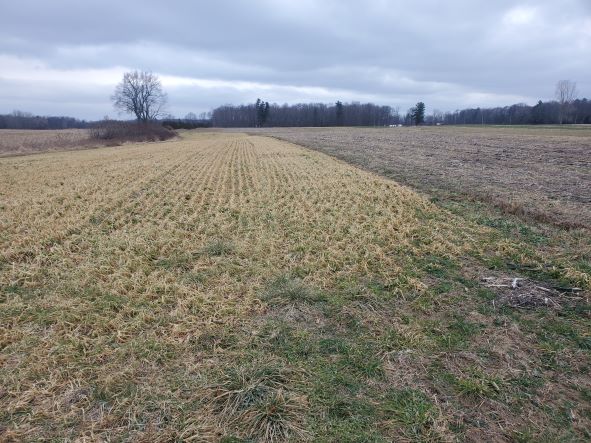
|
|
Jan 15 2022. The green field on he left is our next crop of
spelt. In the foreground is our last seasons sunflowers which is
showing a lot of clover which will become a pasture.
|
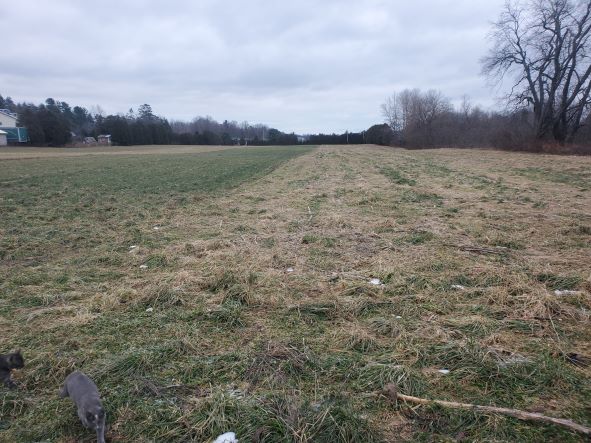
|
|
Dorothee heading out to the woods to cut firewood. Dec 29 ,
2021
|
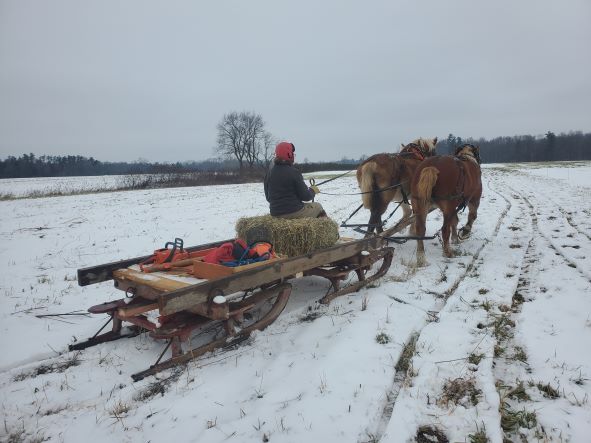
|
|
Just installed the new to us grain bin. Dec 26 2021.
This was quite a feat. I drove 2 hours at 35 kph to pick it up
on my hay wagon and came back 2 hours. Then there was the problem
of setting it up on some cement blocks. Luckily the forklift was
able to do it, but it was a real headache for quite some time as I
thought things through. Hopefully I'll get my bumper crop of oats
in it on a dry sunny day.
|
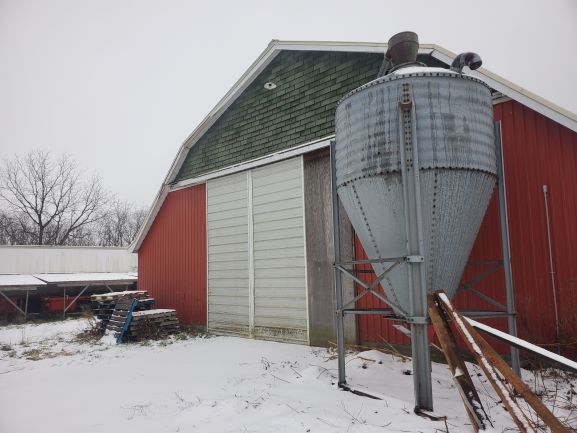
|
|
This is the rebuilt clipper being tested. Unfortunately one of
the bearings was giving me troubles so I decided to replace it.
Needs a few adjustments but it will save me a lot of time using
this cleaner. So back to the workshop.
Dec 21, 2021
|
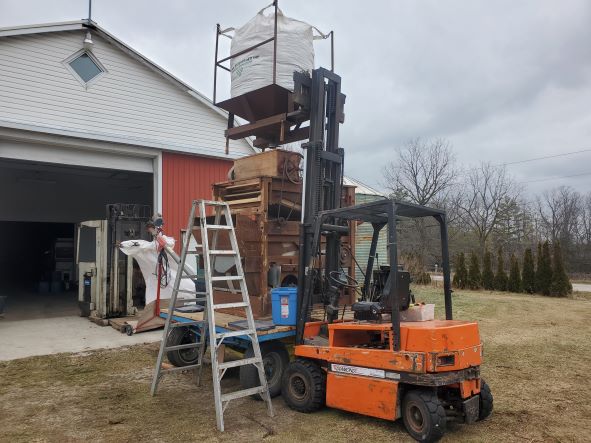
|
|
Some of the trash from the sunflower cleaning.
|
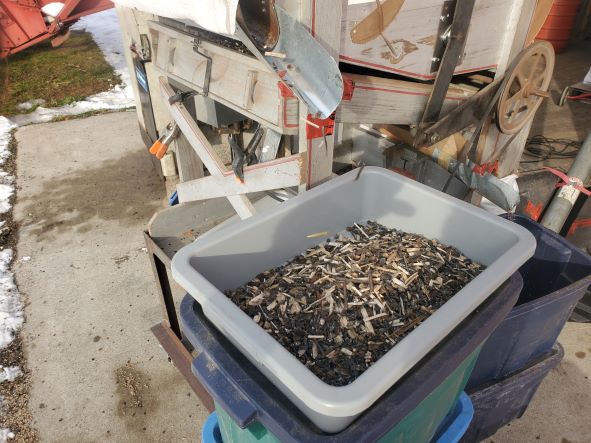
|
|
Cleaning sunflowers DEC 1 2021. This is using the small cleaner
and it is very slow. Have been working on the 1900 vintage clipper
and it should be a lot faster and better.
|
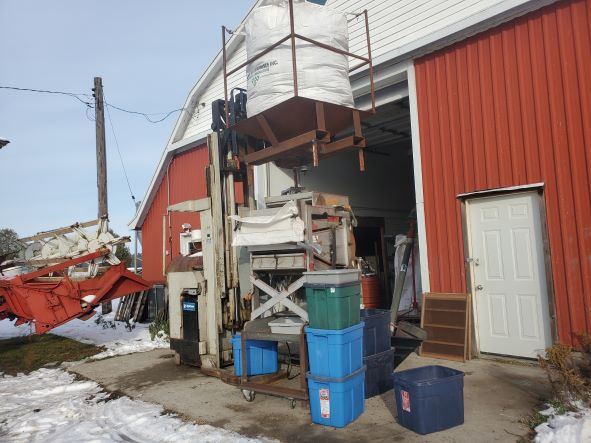
|
|
This is the setup for cleaning camelina. Oct 29 2021
|
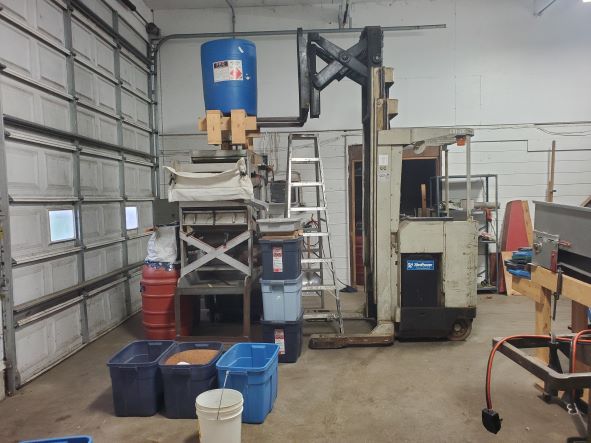
|
|
Oct 25 2021, Mat Plowing with Jim and chief.
|
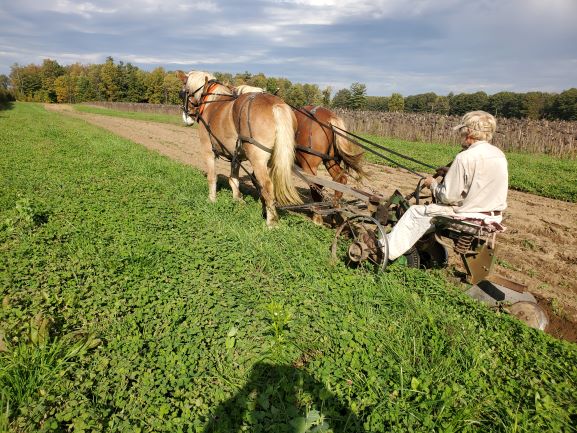
|
|
Using the gravity table to separate out the mustard seed from
the camelina.
|
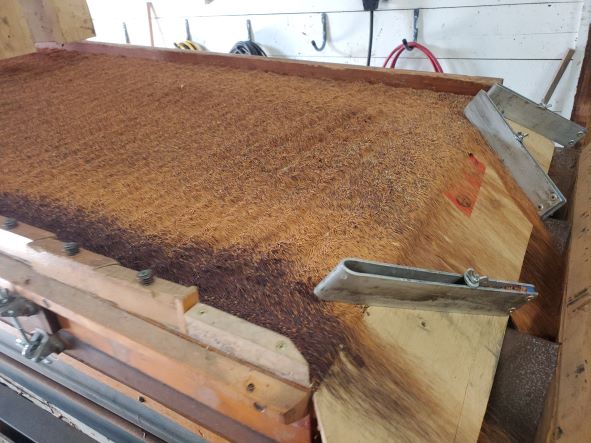
|
|
This is the
dehulling set up for the spelt.
|
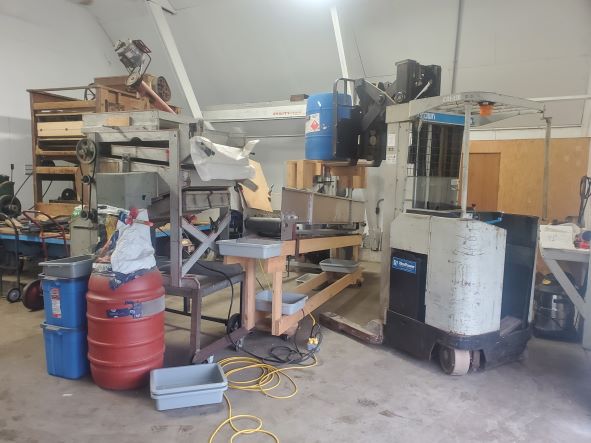
|
Sept 10 2021: Plowing for the spelt field.
|
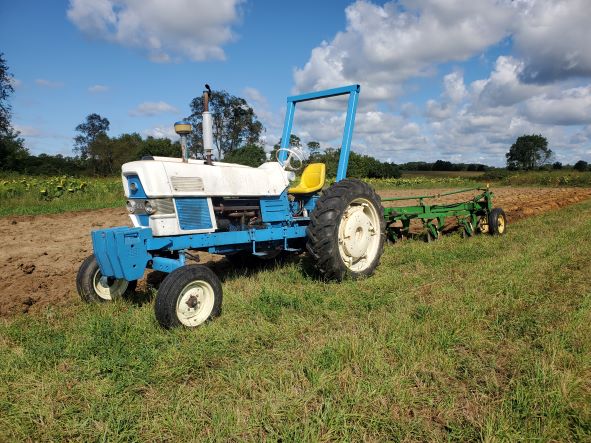
|
|
Sept 10 2021: Laying out the field garden with Mushroom
compost. We used the manure spreader to put down the compost in
long lines.
|
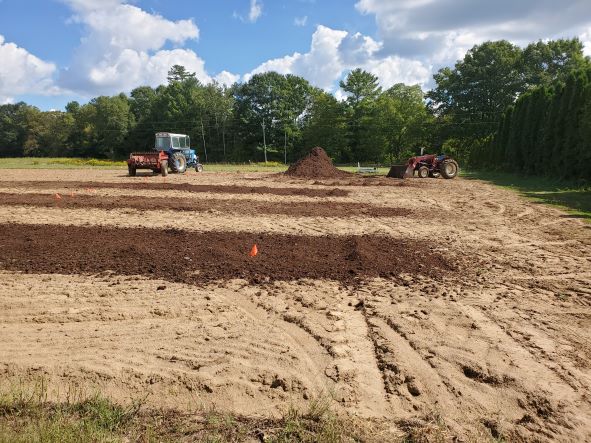
|
|
Sept 10 2021: Using the coulter cart and seed drill to over
seed the pasture.
|
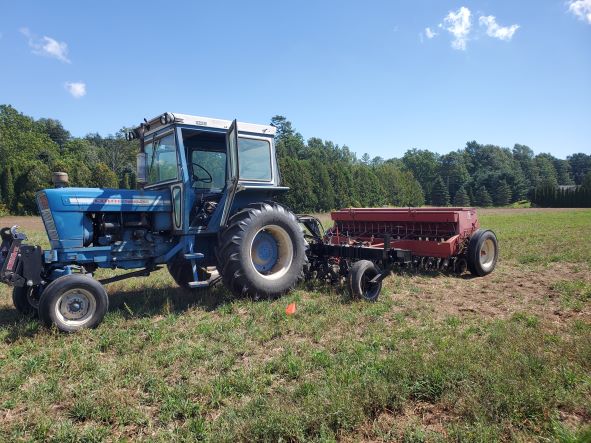
|
|
Early August in the crimped rye/ sunflowers. Very pleased with
the growing white clover in the crimped rye. Sunflowers look good
too!
|
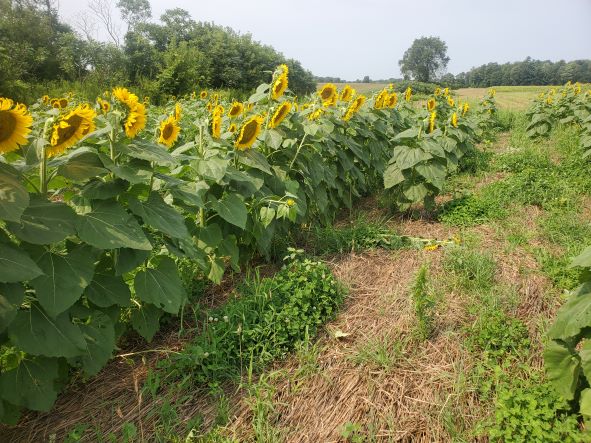
|
|
I planted a field of buckwheat and am trying to crimp it before
planting some rye and clover. Aug 21 2021
|
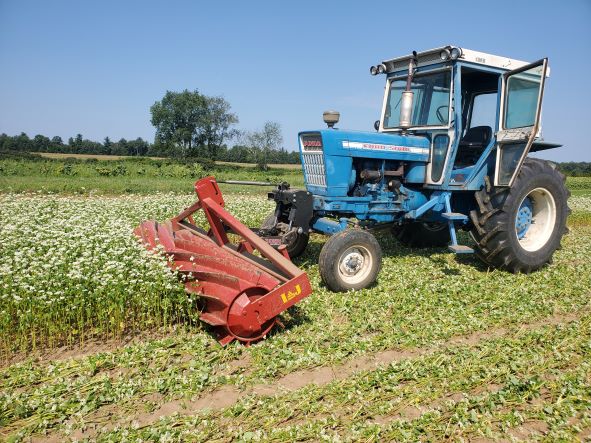
|
|
Finally July 26 2021 we have some emerging sunflowers in the
north field!
|
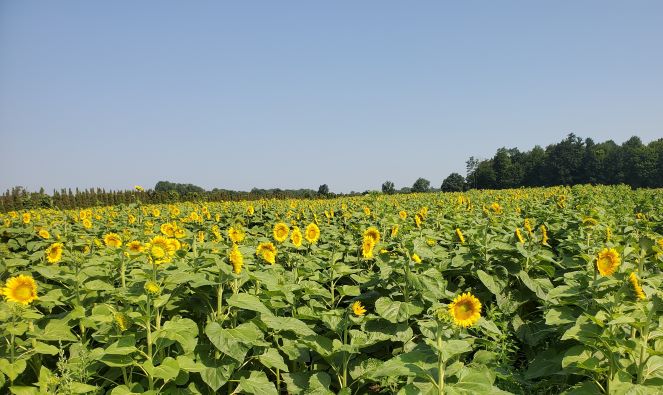
|
|
Mat with Jim. Chief and Duke discing a field ready for a cover
crop of buckwheat.
|
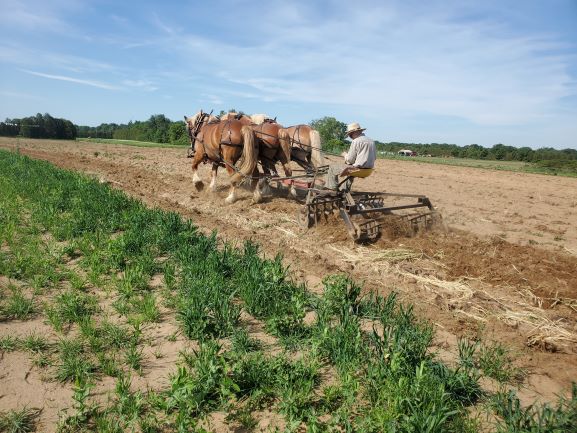
|
|
If you look
closely the keeton seed firmer is just below the crimped rye. May
30 2021
|
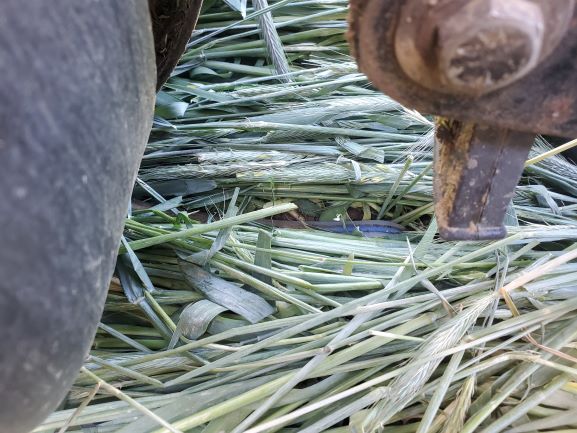
|
|
Just testing
the depth that the planter will need to go through the crimped
rye.
|
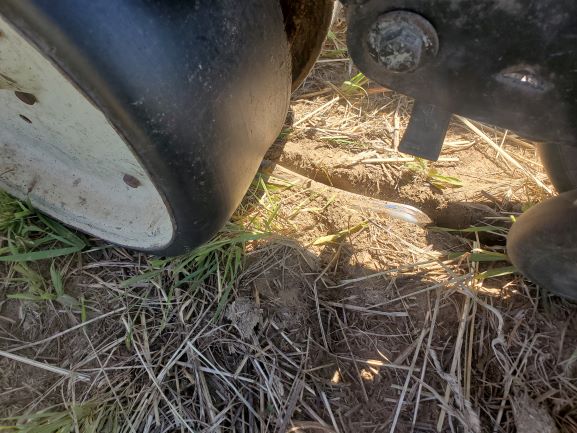
|
|
May 30
2021. Decided to get the horses out and do the last minute
discing to discourage the weeds before planting the corn. I
purchased a rolling basket which I welded up and attached to the
horse drawn disk which works well.
I would rather
do more planting with the no till drill but that's for next year
and better planning on my part.
|
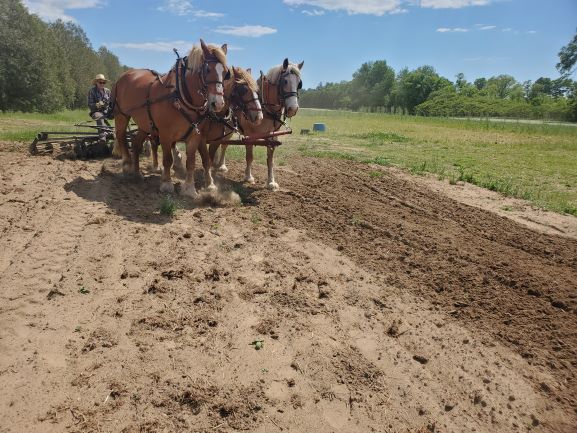
|
|
May 28 2021
Rained today
but just not enough. I'm planning on planting the crimped rye So I
added some heavy weights to the planter.
|
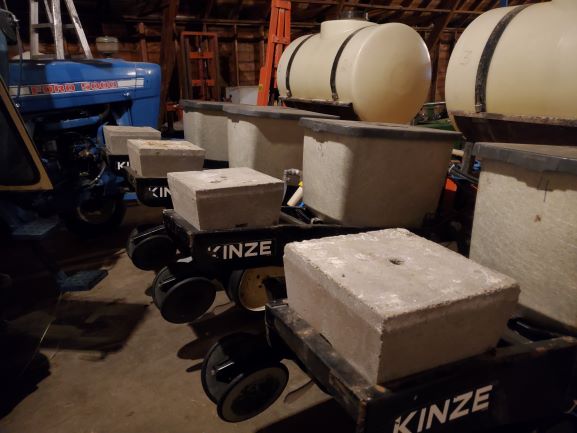
|
|
May 27 2021.
Crimped the rye. It did look like a very good stand but there were
some thin spots. Will plant the sunflowers in a couple of days
after the rain.
|
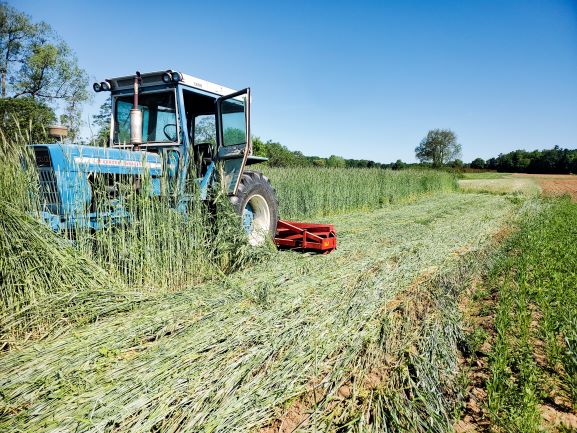
|
|
May 25 2021
The sunflowers
are planted using plan B as the winter kill did not leave enough
residue. Yes I had to plow, pack and disc which is not the thing I
like to do. It was the first time I tried the new to me Kinze
planter. It is normally used in a no till situation but such is
life. Next week we crimp the rye and try the new planter in the
crimped rye.
|
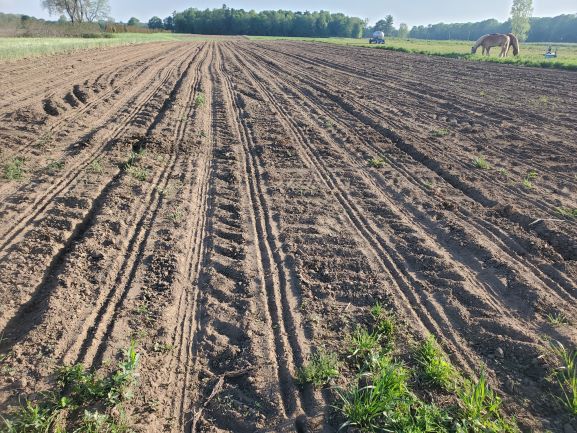
|
|
|
|
|
|
|
|
|
|
|
|
|
May
9 2021
Since “plan A
“ winter kill residue did not work well I had to resort to plan
B which was to plow the field. This left a very bumpy field because
of all the roots which I then packed with the crowfoot packer pulled
by the horses. Once that was somewhat leveled I then disc'd it
lightly with the horse drawn disc with rolling basket. When the
horse gave up I continued with the tractor disc and rolling packer.
Then I followed that with the horse drawn tyne weeder and then on
certain fields like my oats I used an aggressive rotary hoe on the
tractor.
I feel I messed up
on the oats. They just seems to be very slow germinating in this cold
weather so I delayed using the tyne weeder and rotary hoe until the
weeds got established. Now some hand weeding. What a mistake as now I
will have to deal with the weeds and their seeds. In my other pasture
fields I mow them constantly to reduce any flowering weeds which
helps.
I'm learning a lot
in the greenhouse. Yes the sunflowers are growing up through the
mature rye! Even a few crimson clover plants are coming through the
rye in the greenhouse too. Rye really only discourages the very small
seeds from germinating and any large seeds seem to do fine. I was
only able to purchase a coated sunflower seed that I wanted to try
and to my delight I just washed them in water and the coating came
off...so now I have un-coated seeds to try in a field and a separate
field with my own seeds I saved last year .
The warmth of the
greenhouse really makes a difference to how well things grow!
I purchased the book
by Jeff Moyer and have found it a great help to working with the
roller crimper.
April 29 2021
I planted sunflowers in a pot of rye that I had dug
up from the field where I intend to crimp the rye. The rye field
looks terrific and hopefully this s a good sign that the sunflowers
may germinate in the crimped rye. I could also consider planting
green as well then crimping. I must also watch to see if there is
enough nutrients for the sunflowers to mature.
The other
field for the sunflowers that was supposed to have a good amount of
residue from winter kills did not work out very well so I moved to
plan B and I had to plow it. Since the field was full of roots the
result was very bumpy and rough which I then rolled with the crowfoot
packer. That went quite well except it was a little too heavy for the
horses and I finished it with the tractor. Now that I got it smoothed
somewhat I then did a very light discing. My plan B is getting more
complicated and I will have to cultivate the sunflowers to keep the
weeds down. On the last cultivation I will spread red clover.
In
an other area I harvested oats last year and did a no till with my
seed drill for pasture and it seemed to work quite well on my sandy
soil.
I thought I would try to get some new sunflower seeds
but nusun has purchased the other sources of sunflower seed and I
could only get a very small size seed coated with a fungicide which
does not make me happy.I have been developing my own seed which has
been fairly successful.
I was fooled by the warm weather in
march but I did get my oat multi mixture planted and it is up and is
not affected by the frost. I also did a multi specie pasture mix
which has been a little slow but it is showing.
April 8 2021
I have a post hole auger which I am able to loan out
to any one who needs one.
Got my oats planted. Along with the
oats I am also planted clovers, flax and peas. My new pastures are
now planted with multi species.
The horses are preparing the
sunflower fields by eating the cover crop, leaving manure and urine
then lightly tilling the soil with their hooves.
Now I need
rain.
mat
April 8 2021
Got my oats planted. Along with the oats I am also
planted clovers, flax
and peas. My new pastures are now planted with multi
species.…
March 9 2021
I found my various sizes of plastic bottles for
dispersing the Growo vericompost extract so whomever wants to try
some please let me know the quantity. I suggest a 1-2 liter amount.
If there is not much response I will be generous to those who
want to try it
If there is not much response I will be generous to
those who want to…
March 9 2021
recent Message from Andrei:
Firstly about the
seeds: spray them with solution 24-48 hours before sowing-not for 24
hours. Just so there are wet. Enough time to dry. In big farms
or seed distribution they use fumigator(or something like that and
our product can be added to fungicides).
Now for amount. Yes
it's 100 l of solution per acre per application.
For your soil it
could be beneficial to spray soil before planting in addition ti 2
applications during growing period.
Andrei
March 8 2021
Seed soaking coverage is 1:30 and corn with a liquid
fertilizer set up is 1:100
I'll get more infor
March 7 2021
Price of the Growo vericompost extract
The price of the product is 19.50 per litre. But for
the moment I have a 10 liters which I am very glad to disperse
amounts those interested at no cost.
March 7 2021
While I am very skeptical of most products I am
willing to give some a try. This is one of them
I have a 10
liter jug of liquid vermi compost extract that I want to
share. Andrei Fravtchenko is the owner and operator of GROWO. He
visited with me on saturday and left me a jug which I would like to
share with anyone who is interested. His phone is 226 448 6999 london
area.He may not be able to answer all the questions but he can find
the answers.
The extract is made in Latvia and he would like
to bring the process here.
He says that applying it to seeds
by soaking for 24 hours has the best response but you can also try on
corn at 1:100
Attached is the Lab report from Latvia where
the process is done. It is very interesting to hear from some of the
Russian countries that are also working on soil health.
Some
of the literature on this product:
The extract has bio
fungicidal and growth stimulating properties, that is, the ability to
provide plants with biological protection and accelerate growth and
development. This is possible due to a complex of micro-organisms
that are in the vermicompost, but they appeared there from the
intestine of the worm. About 90 species of different soil organisms
are found in the products after worm processing. It is due to
nitrogen fixing, phosphate and potassium dissolving micro-organisms,
rhizobacteria, cellulosolytic and mycorrhizal arbuscular fungi, which
from the vermicompost go into the extract and this effect is
possible.
Stimulates biological processes
Provides the
plant with food throughout the growing season
Increases the
sprouting and energy of seed germination
Enhances the growth and
development of plants
Increases immunity and adaptogenic
properties
Promotes anti-stress resistance to environmental
conditions
Reduces maturation for 10-14 days
Promotes yield
increase up to 30-40%
Increases the content of vitamins, mono-
and polysaccharides
Improves the quality of fruit, nutritional
value
Prolonged storage time
Inhibits the development of
pathogenic microflora
Has a protective function against insect
pests
Marc 6 2021
My thoughts on soil health
Hi all, been thinking how to weigh in on this but Ken
did a real good job, especially the ideas from opposite ends of
spectrum, and needing both
On 2021-03-03 7:01 p.m., Ken and Martha Laing wrote:
Hi Mat and everyone
Unfortunately one side says
you can ignore the chemistry and the biology will do everything and
the other side says you can ignore the biology and play with the
chemistry and everything will be fine.
Like in many things the truth
is probably somewhere in between these 2 extremes. There
are 3 equally important aspects of soil - the physical, the
chemical and the biological. They are very connected and
interdependent on each other. The physical aspect is very much about
the air, pore space, soil aggregates, water movement and retention.
Tillage and compaction are 2 big factors in the degrading of the
physical aspect. The biology is dependent on proper aeration, water
and housing - benefits all provided by good soil aggregation.
Good aggregation is the result of good biology. Growing plants
provide the carbon materials biology needs to multiply and reproduce
and in turn the biology helps supply the plants with nutrients, water
and disease control. The biology helps glue soil particles together
to form aggregates. That is sort of back where we started. Soils
differ in their inherent amounts of different plant nutrients
depending on their texture and parent materials from which
they formed. Yes, any soil will support a population of
plants. The rub comes when we want to cultivate these soils and grow
crops that are not naturally suited to that soil. Then it is
important to measure [soil test] and find out what may be lacking for
the particular crop we want to grow. That requires that we understand
the chemistry in the soil/plant and amend if necessary. Maybe
someday in the not too distant future we will be able to say
this nutrient is not available to the plant and we need this microbe
to make it available but we do not have that science yet.
Heard my first Redwing Black
bird today.
Ken Laing
March 4 2021
The address below takes you to a webinar talking
about the haney test and an excellent talk by Sarah Hargreaves of
ontario to the Practical farmers of Iowa.
In the presentation
there is talk of using less fertilizer. I found that Sarahs talk
helped me understand more about the complexity of the soil microbes.
Sarah mentions that the measurement of slow growing microbes may be a
most important indicator of soil health. And the PLFA (fatty acid)
method measurement may be one of the best.
But even with all
of this I still need to find out what is best for my soils, my
climate and my abilities. Seems compost is about the best thing I can
do.
https://www.youtube.com/watch?v=FPEB4acLEjc
March 1 2021
My
understanding of soil health by Mat
The chemistry of the soil does not matter as much as the
microbial life in it.
Soil microbial life varies greatly by temperature,
moisture and the needs of the surrounding plants.
The microbial life in the soil varies accord to the
needs of the plant as the plant will signal and send out stimulants
to encourage certain nutrition needs of the plant. This being so the
co2 measurement of microbial action may vary.
Perhaps our old way of measuring the chemical analysis
is not longer as valid.
The haney test advises against too much fertilizer into
the soil which plugs our waterways
We need to know our soils well to avoid too much
fertilizer inputs.
Electrical conductivity in sandy soil is not so
good.
Energy is going to be the most expensive item in the
near future so those heavily dependent on conventional herbicides and
insecticides may have to investigate organic farming.
Sarah Hargreaves has an excellent talk on microbes in
the soil and measuring them. I'll pass that along once I talk with
her.
Sarah mentions that the measurement of slow growing
microbes may be a most important indicator of soil health. And the
PLFA (fatty acid) method measurement may be one of the best.













































































